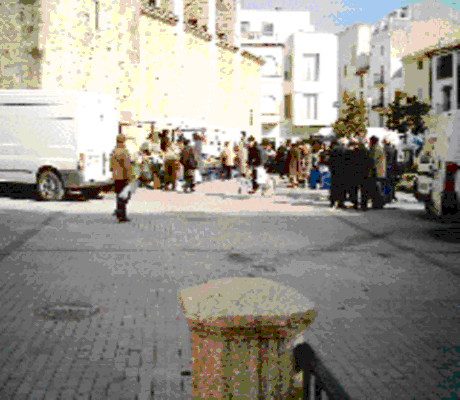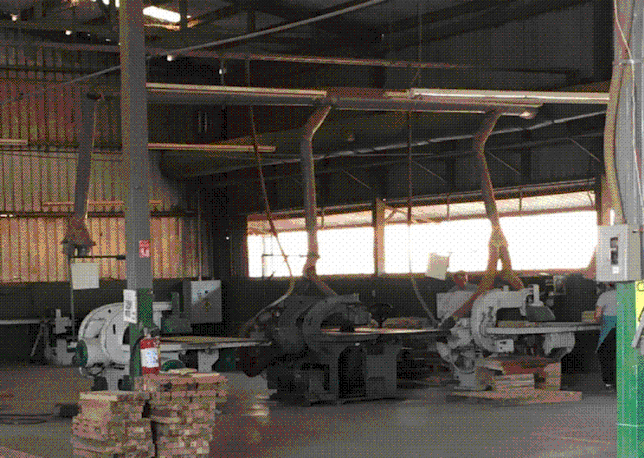|

The market in the Plaza Mayor
THE TRADE:
 
The commercial activity of Kenya has always been limited
By its character of small population, besides that it was one of the first towns of the peninsula in disposing of
Public lighting, apart from this has been considered throughout the twentieth century, the third district market of Montsia,
With the particularity that attracts commercial activity of the neighboring district of the Lower Maestrat, especially of the populations
Of Rosell and Sant Rafael del Rio, as well as of the neighboring populations of the tinença of Benifasar. This is the result
Of its geographical situation, on horseback between the Catalan and Valencian lands. For the same reason, since always,
The medical, commercial and professional services have been oriented towards Tortosa and a part of the aspect
Commercial to Vinaroz.
The traveling market takes place twice a week to the main square, Wednesday and Saturday. Even now the older people are referring
To sellers of vegetables and fruit with the name of "canareves", making reference to the families of the population
Neighbor of Alcanar who went up with the carts twice a week to sell the produce of their orchard. On saturdays there are
Clothing market and other products, while on Wednesdays most of the stops are made of edible products
(Fruit vegetables, etc.).
The traditional trades of the municipality are not different from those of the majority of populations of its magnitude:
Grocery stores, butchers, shoe shops, clothing stores, haberdashery, hardware stores, pharmacies, hairdressers, bars and
Taverns ... Before the fifties some were tied to crafts. Is the case of the alpargaterias,
Soap makers, those who made noodles ... to name a few.
The year 1979 of the 76 licenses of commerce that had in the population 29 were of the alimentary branch and 12 of the textile.
Currently this proportion has varied greatly thanks to the clear predominance of furniture stores, which attract each week
A large number of buyers coming from a radius of more than 200 Km. Since the 70's the proportion of shops
Dedicated to the sale of furniture has progressively increased to reach the current 30 stores. The origin of this
Phenomenon is due to the process of diversification of the furniture and accessories industry that has taken place in the
municipality
THE INDUSTRY:
The municipality of the Sénia was traditionally considered a community of peasants until the end of the 18th century. is from
This time when you can start talking about the senienca industry.
Throughout the eighteenth and nineteenth centuries, near the river Sénia and within the urban core were installed different industries
Of transformation of raw materials. The former were flour and oil mills, then the paper industry
(Formerly they spoke of "mills raperos" because they used the rags like raw material) and the martinets, between the
Centuries XIX and XX are put into operation power plants and finally the twentieth century highlights the industry of brushes
And furniture.
The eighteenth century had documented 7 mills of paper mills. This industry gave way to that of oil mills
Compatible 25 bar mills in the year 1930 and 12 hydraulic mills after the civil war.
An important industry in the twentieth century was that of brushes. The first of these I install J.Calduch nearby
Of the river in an old mill of flour that also had been mill of oil. From this company came good workers
Who were later owners of their own industry.
La Sénia has a long tradition in the work of wood. The proximity of the Mountain Ports, the proliferation
Of trades related to the approval of the forest mass and the existence of an important nucleus of mills
Preindustriales in Rio sénia favored from the nineteenth century the development of the traditional craft of carpenter.
The origin of the current furniture factories is found in the carpentries of the early twentieth century.
 
Between the years 1940 and 1950 they appear a series of small industrial establishments, heirs of carpentries
Previous or founded by people who learned the trade in these. On a very small scale start to apply
Industrial processes to the manufacture of furnitures.
In the decade of the 60 is when we found small and medium companies that had implanted manufacturing processes
Machinery and an organization of the production that can be considered fully industrial. The first factories
That developed the whole productive process from the purchase and drying of the wood to the final finish of furniture.
In the 70's factories specialized in different parts of the process of manufacturing and selling furniture.
It begins the new ivy in which furniture companies function as "factories of mantaje". The general crisis
Of the years 70-80 makes the mentality of the sector change and once the industrial implantation has been overcome to the Sénia
Is fully consolidated. Today, the wood, furniture and accessories sector occupies almost the whole
Of the workers of the population and the sector has been strengthened by the projects of location in the Sénia
The center of technological diffusion of the furniture of Catalonia and the plant for the treatment of wood waste.
The dominant production is the modern and design furniture, destined for the Catalan and Espanyol market and the
Export to Europe, Asia and America. The data of the annual billing of the area has become the first
Producing area of the modern furniture of Espanya and furniture of Catalonia. Recently the Generalitat de Catalunya has
Recognized this long tradition in the manufacture of furniture of interest Artesanal de Catalunya in the manufacture of furniture.

Clicking on the bird goes to the home page
|
 Català:
Català:
 Castellà:
Castellà:



